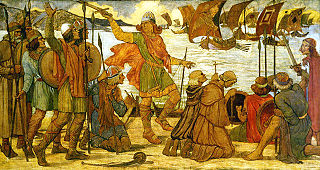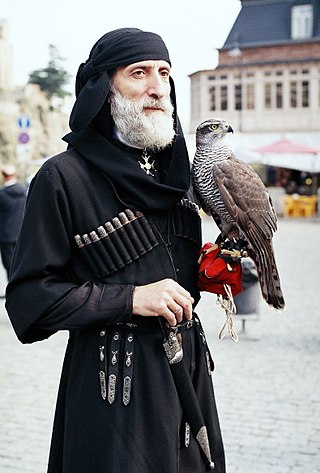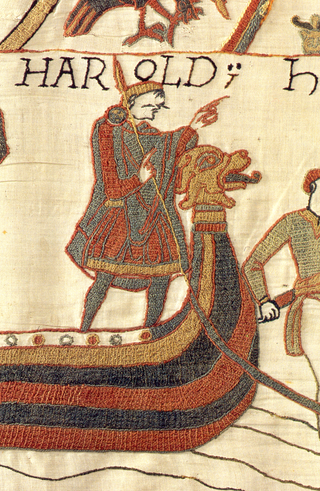This article needs additional citations for verification .(December 2011) |
Eunjangdo is a type of silver knife or norigae historically worn in Korea.
This article needs additional citations for verification .(December 2011) |
Eunjangdo is a type of silver knife or norigae historically worn in Korea.
In the Joseon Dynasty period, both Korean men and women generally wore jangdo. During this period, jangdo developed in many aspects. The design, material, and techniques developed to produce eunjangdos in various way. The court also used geumjangdos and eunjangdos. [1]
The eunjangdo was prohibited to be worn by the common people in the period of Yeonsangun reign (1498), but the prohibition had a limited effect. In the period of Hyunjong (1670), there was a law that would penalize common people for use of eunjangdos. The reason for this restriction was the importance of gold and silver. In a feudal society, gold and silver were indicators of social hierarchy.
Eunjangdo is a multi-purposed knife and at the same time has the characteristics of an accessory.
When women wore jangdo they had a breast-tie, called paedo and pocket called nangdo.
The material used to make eunjangdos is silver and the blade is steel. Some eunjangdos' sword blades were engraved with single-minded devotion, because eunjangdos were a symbol of fidelity.
Some eunjangdos contain chopsticks, so that when people eat out, they can use chopsticks that they know are safe from poisoning. [2]
The eunjangdo appears in the second episode of Cobra Kai season 6 "The Prize" as an ancient family knife John Kreese recovers for his master. It later appears in episode ten, "Eunjangdo."

Jewellery consists of decorative items worn for personal adornment such as brooches, rings, necklaces, earrings, pendants, bracelets, and cufflinks. Jewellery may be attached to the body or the clothes. From a western perspective, the term is restricted to durable ornaments, excluding flowers for example. For many centuries metal such as gold often combined with gemstones, has been the normal material for jewellery, but other materials such as glass, shells and other plant materials may be used.

A Japanese sword is one of several types of traditionally made swords from Japan. Bronze swords were made as early as the Yayoi period, though most people generally refer to the curved blades made from the Heian period (794–1185) to the present day when speaking of "Japanese swords". There are many types of Japanese swords that differ by size, shape, field of application and method of manufacture. Some of the more commonly known types of Japanese swords are the uchigatana, tachi, ōdachi, wakizashi, and tantō.

A scabbard is a sheath for holding a sword, dagger, knife, or similar edged weapons. Rifles and other long guns may also be stored in scabbards by horse riders for transportation. Military cavalry and cowboys had scabbards for their saddle ring carbines and rifles for transportation and protection. Scabbards have been made of many materials over the millennia, including leather, wood, and metal such as brass or steel.
A tachi is a type of sabre-like traditionally made Japanese sword (nihonto) worn by the samurai class of feudal Japan. Tachi and uchigatana generally differ in length, degree of curvature, and how they were worn when sheathed, the latter depending on the location of the mei (銘), or signature, on the tang. The tachi style of swords preceded the development of the katana, which was not mentioned by name until near the end of the twelfth century. Tachi were the mainstream Japanese swords of the Kotō period between 900 and 1596. Even after the Muromachi period (1336–1573), when katana became the mainstream, tachi were often worn by high-ranking samurai.

A necklace is an article of jewellery that is worn around the neck. Necklaces may have been one of the earliest types of adornment worn by humans. They often serve ceremonial, religious, magical, or funerary purposes and are also used as symbols of wealth and status, given that they are commonly made of precious metals and stones.

Sandals are an open type of shoe, consisting of a sole held to the wearer's foot by straps going over the instep and around the ankle. Sandals can also have a heel. While the distinction between sandals and other types of footwear can sometimes be blurry, the common understanding is that a sandal leaves all or most of the foot exposed. People may choose to wear sandals for several reasons, among them comfort in warm weather, economy, and as a fashion choice. Usually, people wear sandals in warmer climates or during warmer parts of the year in order to keep their feet cool and dry. The risk of developing athlete's foot is lower than with enclosed shoes, and the wearing of sandals may be part of the treatment regimen for such an infection.

Knowledge about military technology of the Viking Age is based on relatively sparse archaeological finds, pictorial representations, and to some extent on the accounts in the Norse sagas and laws recorded in the 12th–14th centuries.

The hanbok is the traditional clothing of the Korean people. The term hanbok is primarily used by South Koreans; North Koreans refer to the clothes as chosŏn-ot. The clothes are also worn in the Korean diaspora. Koryo-saram—ethnic Koreans living in the lands of the former Soviet Union—also retained a hanbok tradition.

A chokha, also known as a cherkeska, is a Kartvelian woolen coat with a high neck that is part of the traditional male dress of peoples of the Caucasus. It was in wide use among Avars, Eastern Armenians Abazins, Abkhazians, Azerbaijanis, Balkars, Chechens, Circassians,Georgians, Ingush, Karachays, Kumyks, Nogais, Ossetians, Tats, the peoples of Dagestan, as well as Terek, Kuban Cossacks, Kurds from Russian empire who adopted it from the aforementioned peoples.

The Armenian Taraz, also known as Armenian traditional clothing, reflects a rich cultural tradition. Wool and fur were used by the Armenians along with the cotton that was grown in the fertile valleys. During the Urartian period, silk imported from China was used by royalty. Later, the Armenians cultivated silkworms and produced their own silk.

The preservation of fabric fibers and leathers allows for insights into the attire of ancient societies. The clothing used in the ancient world reflects the technologies that these peoples mastered. In many cultures, clothing indicated the social status of various members of society.

Khmer traditional clothing refers to the traditional styles of dress worn by the Khmer people throughout history. Tracing their origins back to the early Common Era, the customary styles of dress worn by Khmer people predate the indianization of Southeast Asia. The evolution of these clothing customs can be traced through archaeological artifacts from the 6th century to the post-Angkorian period, evolving from the simple pre-Angkorian Sampot to vibrant and intricately embroidered silk garments.

Anglo-Saxon dress refers to the clothing and accessories worn by the Anglo-Saxons from the middle of the fifth century to the eleventh century. Archaeological finds in Anglo-Saxon cemeteries have provided the best source of information on Anglo-Saxon costume. It is possible to reconstruct Anglo-Saxon dress using archaeological evidence combined with Anglo-Saxon and European art, writing and literature of the period. Archaeological finds have both supported and contradicted the characteristic Anglo-Saxon costume as illustrated and described by these contemporary sources.

Clothing in ancient Greece refers to clothing starting from the Aegean bronze age to the Hellenistic period. Clothing in ancient Greece included a wide variety of styles but primarily consisted of the chiton, peplos, himation, and chlamys. Ancient Greek civilians typically wore two pieces of clothing draped about the body: an undergarment and a cloak. The people of ancient Greece had many factors that determined what they wore and when they wore it.

Chopsticks are shaped pairs of equal-length sticks that have been used as kitchen and eating utensils in most of East Asia for over three millennia. They are held in the dominant hand, secured by fingers, and wielded as extensions of the hand, to pick up food.

Ancient Egyptian clothes refers to clothing worn in ancient Egypt from the end of the Neolithic period to the collapse of the Ptolemaic Kingdom with the death of Cleopatra in 30 BC. Egyptian clothing was filled with a variety of colors. Adorned with precious gems and jewels, the fashions of the ancient Egyptians were made for not only beauty but also comfort. Egyptian fashion was created to keep cool while in the hot desert.

The clothing of the people in biblical times was made from wool, linen, animal skins, and perhaps silk. Most events in the Hebrew Bible and New Testament take place in ancient Israel, and thus most biblical clothing is ancient Hebrew clothing. They wore underwear and cloth skirts.

Buyao is a type of Chinese women's hair ornament. It is a type of Chinese hairpin which was oftentimes decorated with carved designs and jewelries that dangles when the wearer walks, hence the name, which literally means "shake as you go". The buyao is similar to a zan hairpin, except for the presence of its dangling ornaments, which are its primary featured characteristics. The buyao appeared as early as in the Han dynasty, where only noble women in the royal family could wear it. In ancient times, the use of buyao denoted noble status. Some noble women also put buyaos on their tiaras, making their hair decoration more luxurious than simple buyao. Common material used in making the buyao was gold; the ornaments were typically jade and pearls. Other valuable materials could be used, such as silver, agate, etc. Many centuries after the fall of the Han dynasty, the buyao was introduced to ordinary civilians; and when all women were allowed to wear to it, more variety of materials were used to produce them. Buyao was passed down over generations; buyao decorated with pendants are still popular in modern-day China.

The Turco-Mongol sabre, alternatively known as the Eurasian sabre or nomadic sabre, was a type of sword used by a variety of nomadic peoples of the Eurasian steppes, including Turkic and Mongolic groups, primarily between the 8th and 14th centuries. One of the earliest recorded sabres of this type was recovered from an Avar grave in Romania dating to the mid-7th century.